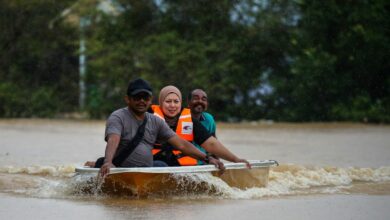For some odd reason, the first thing I could think of after booking my flight to Malaysia was extreme sports. I have never tried my luck with any extreme sport before–except for a roller coaster in Egypt famous for its danger level–but I’m always up for a new challenge. For some reason, Malaysia, which had I never before visited, seemed like the place to play out my extreme sports fantasy. Indeed, my gut feeling could not have been more accurate.
The adventure started with roaming Kuala Lumpur and enjoying the warm but humid weather. The tourist-friendly city is easy to navigate, with a number of different transportation options including the monorail, the underground, and coupon taxis (you buy a coupon from a taxi station for a set price to take you from point A to point B). Even on the more crowded streets, the noise of cars is at a minimum–a huge contrast to the cacophony of Cairo's streets.
As we left the Petronas Twin Towers, which were the world's tallest buildings between 1998 and 2004 and still are the tallest twin towers in the world, we headed to the Kuala Lumpur Tower to witness a parachuting competition that was underway at the time of our visit. The Kuala Lumpur Tower, which was built back in 1995 and is the 18th tallest freestanding building in the world, is 335 meters high and used both for communication purposes and as an Islamic “falak” observatory to sight the crescent moon in order to mark the beginning of Muslim month of Ramadan.
But that’s not all: The tower also holds an annual race in which participants race up the tower's stairs, as well as an annual parachuting event, and in addition it's the launch pad of the famous "Flying Fox" challenge.
The "Flying Fox" is the largest bat in the world, known in Latin as pteropus, and it's also the name for an extreme sport whereby a cable connects a small 100-meters-high launch pad to another pad lying flat on the land, and participants wear a special outfit that connects them by wire to the cable, allowing them to slide down the cable all the way from the launch pad to the landing pad.
For just 30 Malaysian ringgit (the official currency of Malaysia, equal to almost LE1.7) you can put on the heavy outfit and a big helmet and sign a waiver releasing the organizers from responsibility for any injuries or accidents during the stunt, before heading with a pair of instructors to the launch pad.
One of the two instructors jumped first, with such grace that the whole thing seemed to be too easy. The other, holding two hooks connected to my outfit, hooked the first to the launch pad itself, securing me, while he hooked the other wire to the cable. I was still in a cheery mood, willing myself to forget how high up we were, while the guy unhooked the security wire and gestured me to slide.
There I hung, on the other side of the cable, gazing at the high launch pad I had just jumped off, noticing how my fingers were trembling. The first second I was on my own, hanging from the sky, was extremely scary, but the fast slide and an amazing feeling of freedom took over, and half way down the cable I took a 360 degrees turn around myself before landing on the ground where the other instructor secured my landing.
I couldn’t resist taking another jump.
As we were about to leave, my friend and I stood for a while, gazing up the tower, watching the people parachuting. I imagined their feelings as they let go of their body to drop from a height of 300+ meters. For a short while they would just free-fall, before they pulled the strings and the parachute opened. A police officer was standing on the landing trail waiting for them, securing the place for their landing, making sure no passers-by got in the way, unaware of the flying person landing from above.
Parachuting was in my near future, I just didn’t know it at that time.
After traveling around Malaysia for two weeks, we decided to stay at a resort on an island called Langkawi. The beautiful sandy beach on the Indian Ocean was a picture-perfect earthly haven that invites you to simply lay down on the sand and enjoy a good book. The unchanging warm weather throughout the year, the beautiful waves of the Indian Ocean, and the sweet feel of the sands on your feet are the ultimate pleasure as you take a late night walk under the clear sky.
The beach, however, was busy with water activities, including the usual suspects (banana boats, jetskis and the likes). One thing, however, caught my attention.
Parasailing was a rather novel concept to me. The idea of parasailing is simple: A person is towed behind a boat while attached to a specially designed parachute, known as a parasail. The boat then drives off, carrying the parascender into the air. Imagine all that, however, with the scenery of a Malaysian coastline spread out beneath you.
Five kilometers of parasailing costs only 50 ringgit, and the instructor, a short, shirtless Malaysian guy will force you to don a life jacket underneath the wires connecting you to the parasail and inundate you with instructions before allowing you to fly off.
“When boat start go, run,” he said, using only the verbs necessary. “See flag [he points to a flag waving in his hand], pull red.” One of the wires of the parasail had a red ribbon tied on it, which you must pull hard to be able to land after your journey.
Suddenly, the boat was on the move, and so was I.
Three steps toward the sea, and my feet were no longer on the sand. Seconds later I was flying over the ocean, overlooking the small islands covered in trees. One of the islands looked like a ring surrounding a small lake (or was it part of the ocean water? I couldn’t tell). I couldn’t help but curse in amusement.
The winds were taking me higher, and the boat was flying over the waves underneath me. As I was heading back, people stood watching me land with big smiles on their faces. A sunbathing Australian tourist ran away from my landing point, fearing I would crash into her. Then, after ten minutes up in the air, I was back on my feet, and on the ground again.




